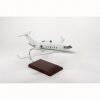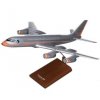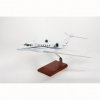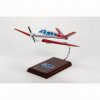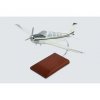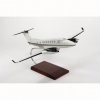"The Douglas DC-3, first flew on December 17, 1935, is a fixed-wing, propeller-driven aircraft whose speed and range revolutionized air transport in the 1930s and 1940s. Many names and numbers were assigned to the DC-3. England labeled it the ""Dakota"" or ""Dak."" American pilots, during World War II, called it the “Skytrain”, ""Skytrooper”, ""Doug,"" or ""Gooney Bird."" The U.S. military’s official titles were C-47, C-53, C-117, and R4D. The airlines called it ""The Three."" Of all the names the affectionate title ""Gooney Bird"" lingers on. The D-13 had a lasting impact on the airline industry and World War II. It was generally regarded as one of the most significant transport aircraft ever made. The D-3 was intended at the height of the depression and in the infancy of the Airline Industry by Douglas Aircraft Company. It carried 34 passengers in more comfort than previous airliners. D-3, a much faster, more efficient and safer airplane, was purchased by many airlines all around the world. Production was diverted during World War II to the C-47 military version and many civilian airliners were converted to the military requirements for use during the war. After the war, most of the DC-3s and C-47s were returned to civilian and commercial use and others were sold to allied air forces around the world. The DC-3 once again was carrying paid passengers and was still in service carrying passengers in the 1970s with a few airlines. Today the DC-3s are relegated to aircraft museums, graveyards and occasionally a charter outfit still carrying cargo in them. "
Scale: 1/72 scale model
Wing Span: 16
Length: 11
KDC3AAT
|
"DC-3 is generally considered as the most famous airliners and it earned the title of ""The only replacement for a DC-3 is another DC-3."" On July 1, 1933, the DC-1 made its first successful flight. TWA evaluated the DC-1 and additional requirements resulted a fourteen-seat DC-2 with a more powerful engine. The DC-2's maiden flight was on May 11, 1934. There were 108 DC-2s produced. In 1934, it set a record of a coast-to-coast time of 13 hrs and 4 min. In the mid-1930s, the DC-3 incorporates all of the technological advances, a reliable, high-power air-cooled piston enignes, a variable-pitch metal propellers, a retractable landing gear, a duraluminum-alloy fuselage and wings and the electronic autopilot. It laso incorporates two 1,200-horsepower Pratt and Whitney engines and it cruised at a remarkable 145 knots at altitudes of up to 10,000 feet. It could carry at least twenty one passengers. The DC's maiden flight was on December 17, 1935, which was the 32nd anniversary of the Wright Brother's first slight. The DC-3 was designated by many names, infact, all are considered their official names; its manufacturer called it the ""Skytrain"" and airlines simply called i the ""Three""; the US Army called it the ""C-47""; the US Navy called it the ""R4D"" and was designated as ""Dakota"" by the British. It was referred by many pilots and was fondly called as the ""Gooney Bird."" It was considered to be one of the four most significant weapons of the War."
Scale: 1/72 scale model
Wing Span: 16
Length: 11
KDC3TWAT
|
"The DC-3, the classic airliner, and American Airlines that ordered it, are responsible for the spectacular growth of air travel. The DC-3 is a superior aircraft and its introduction by American Airlines marked the new beginning of a new era in passenger aviation. In November 1936, the United Airlines, a subsidiary of Boeing, became the second DC-3 customer. Initial orders from American and United Airlines were soon followed by other orders from 30 airlines in the next two years. The DC-3 is universally known as one of the greatest airplanes of all time. The DC-3 is not only comfortable and reliable but it also made air transportation profitable. It also has proven to be tough, flexible and easy to operate and maintain. Currently, hundreds of DC-3s are still operational and in flying condition. "
Scale: 1/72 scale model
Wing Span: 10.25
Length: 7
KDC3UAT
|
"The Bombardier Challenger 600 series is a family of business jets designed by Bill Lear and produced first by Canadair until that company was bought by Bombardier Aerospace in 1986. • CL-601-1A - refined version including winglets to reduce drag and more powerful General Electric engines. (66 built, including 4 CL-144s) o CL-601-1A/ER - 601-1A retrofitted with the 601-3R's additional fuel tank • CL-601-3A - further uprated engine and a glass cockpit. This was the first version marketed by Bombardier. o CL-601-3A/ER - 601-3A retrofitted with the 601-3R's additional fuel tank • CL-601-3R - extended range version with an extra fuel tank added to the aircraft's tail "
Scale: 1/48 scale model
Wing Span: 16
Length: 17
KC601TR
|
The C-90 King Air prototype first flew on January 20, 1964. The civilian model of the King Air began in late 1964. The C-90 King Air has a pressurized cabin and has a maximum seating capacity of 10 people, including the pilot. On September 1970, the improved King Air was introduced and has an advanced pressurization and heating system for the cabin. There's a total of 507 C90s built.
Scale: 1/32 scale model
Wing Span: 19
Length: 13
KC90KATR
|
"The Convair 990 Coronado is a jet airliner manufactured by Convair. In 1961, the first 990 Coronado entered production. The 990 was considered the fastest passenger jet since it was built with a speed of about Mach 0.91. There were original plans to use the bulges of the 990 Coronados as fuel tanks. In 1963, there were only 37 990s produced. The 990 Coronado has a crew of three and has a seating capacity of 96 to 121 passengers. It has a maximum speed of 534 knots and a range of 4,700 nm. The primary user of the 990 Coronado was the American Airlines. There were several 990s which survived. A former Swissair Convair is currently on display at the Swiss transportation museum in Verkehrshaus, Luzem, while two 990s are owned by the Mojave Spaceport. Of these, one 990 is on display at the airport's entrance and the other is used for movie and television filming projects "
Scale: 1/100 scale model
Wing Span: 17.5
Length: 15.25
KC990AAT
|
"The Cessna Citation X is currently the fastest business jet and flying civilian airplane in the world with a traveling speed of up to 605 mph. In October 1990, the National Business Aviation Association Convention in New Orleans announced the development of the Citation X. The certification of the Cessna Citation X was delayed several times. The main reasons for the delays were the avionics and the engine integration failure to the aircraft, the engines also didn't pass the bird strike criteria and directional stability challenges. The certification was finally approved on June 3, 1996. In June 1996, the first Citation X was delivered to Arnold Palmer, a golfer and avid Cessna customer. The Citation X continued to set speed records. In January 1, 2002, all Citation X underwent upgrade and the main characteristics of the upgraded version are a 5% increase in thrust, a 400 lbs increase in maximum take-off weight and improved Honeywell avionics. The Citation X incorporates a number of innovative design features; large diameter of the engine intakes, reduced noise from the engines and improved fuel efficiency. The Citation X was also the first aircraft from Cessna to use a Rolls-Royce engine and fully-integrated avionics. Despite Cessna's long history of building business jets and the number of aircraft in the Citation family, the Citation X was a completely new design, not a derivative of earlier Citations. The Cessna Citation X is currently the fastest civilian aircraft being flown, though the Concorde and Tupolev Tu-144 were both faster, but they are no longer in service "
Scale: 1/40 scale model
Wing Span: 10.1
Length: 20
KCC10
|
"The Cessna Citation X is a medium-sized business jet aircraft built by the Cessna Aircraft Company in Wichita, Kansas. The “X” stands for the Roman numeral for 10 and not the letter. Powered by two Rolls-Royce turbofan engines, it is the world's fastest operating passenger jet. This seven-person private plane can climb to 43,000 feet in just 30 minutes. It is equipped with an entertainment center and a vanity area for passengers. Despite Cessna's long history of building business jets, the Citation X was a completely new aircraft in many ways. Its wing, tail, tail cone, gear and systems were designed from scratch, not based on pre-existing airplane. It was the first aircraft to use a Rolls-Royce engine and fully-integrated avionics. It also incorporates a number of innovative design features. The large diameter of the engine intakes reduces the noise from the engines and improves fuel efficiency. The highly swept wing with a supercritical airfoil increases the Mach number. The horizontal and vertical stabilizers are highly swept as well and are arranged in a T-tail configuration. The Citation X is equipped with controls that are powered by dual-hydraulic systems for redundancy. Cessna announced that it was developing the Citation X at the National Business Aviation Association Convention in New Orleans in October 1990. The prototype was publicly rolled out in September 1993 and flew for the first time on December 21 of the same year. The first customer delivery was in June 1996, to golfer and long-time Cessna customer Arnold Palmer. Once in use, the aircraft continued to set speed records. Arnold Palmer set one in September 1997, flying 473 knots on a 5,000 km closed course. In February 1997, the Citation X design team was awarded the National Aeronautic Association's prestigious Robert J. Collier Trophy. The 2,500th aircraft was delivered on September 10, 1997. "
Scale: 1/40 scale model
Wing Span: 19.25
Length: 21.75
KCCC10TR
|
"The Cessna Citation Mustang is a business jet built by Cessna Aircraft Company at their Kansas production facility. It was a light business jet, hence it was commonly referred to as a very light jet (VLJ). The Mustang, like any other small business jet, is certified to fly without a co-pilot. The Mustang was first flown on April 23, 2005. On September 8, 2006, Mustang received full type certification from the Federal Aviation Administration. In fact, the Mustang was the first of its class to receive full type certification, first to receive certification to fly into known-icing conditions, the first VLJ to be delivered to a customer, thus, making Cessna the world's first fully certified, new-generation entry level business jet. The Mustang features a wide passenger door and a large eye-level window for natural ambiance and externally accessed luggage space in the front and rear cabin. The Mustang is powered by two Pratt and Whitney Canada PW615F engines with dual FADECs for efficient fuel consumption. The Mustang has a top speed of 340 kn and a range of 1,150 nautical miles and a service ceiling of 41,000 feet which is well suited for getting above weather and commercial traffic for more efficient operations. Cessna Citation Mustang's sales have climbed to 250 units, with the majority coming from international customers, selling out production well into 2009. Cessna plans to enhance its sales and marketing efforts by increasing its domestic and international sales force, conducting intensive demonstration tours with multiple aircraft on a worldwide basis and stepping up its marketing campaign in response to the very high level of interest in the Citation Mustang expressed by customers globally. "
Scale: 1/40 scale model
Wing Span: 12.8
Length: 11.75
KCCM
|
"The Beech V-35 Bonanza is the successor to the legendary Staggerwing and is considered one of the most unique private aircraft, being a good seller for Beech Aircraft for many years. The Beech V-35 Bonanza has a good range and has the ability to haul four or six passengers. The general configuration of the Model 35 has remained unchanged throughout the aircraft's history. The Model 35 has an enclosed cabin which provides seating for a pilot and three or four passengers. The optional feature on the airplane has been a landing gear safety system Beech design."
Scale: 1/24 scale model
Wing Span: 16.88
Length: 12.25
KBC35TE
|
"The A-36 Bonanza Beechcraft model is a general aviation aircraft introduced in 1947 by the Beech Aircraft Corporation. As of 2007, it is still being produced by Hawker Beechcraft. There are more than 17,000 Bonanzas that have been built. The A-36 Bonanza Beechcraft model was designed by a team led by Ralph Harmon. All Bonanzas including A-36 Bonanza Beechcraft Model share an unusual feature: the yoke and rudder pedals are interconnected by a system of flexible bungees which assist in keeping the airplane in coordinated flight during turns. The bungee system allows the pilot to make coordinated turns using the yoke alone, or with minimal rudder input, during cruise flight. The twin-engine variant of the Bonanza is called the Baron, whereas the Twin Bonanza is a different design and not based on the original single-engine Bonanza fuselage. The A-36 Bonanza Beech Model has an improved deluxe interior, a new fuel system, higher take-off weight, from 1985 fitted with a Continental IO-550-BB engine and re-designed instrument panel and controls, 2128 built and it is modified with the Tradewind Turbine's turboprop conversion."
Scale: 1/24 scale model
Wing Span: 16.5
Length: 13.5
KBC36T
|
The Beechcraft Bonanza is an American general aviation aircraft introduced in 1947 by The Beech Aircraft Corporation. As of 2008 it is still being produced in derivative form by Hawker Beechcraft, becoming the longest-running production airplane in history. More than 17,000 Bonanzas of all variants have been built,
Scale: 1/32 scale model
Wing Span: 12.25
Length: 9.75
KBG36T
|
"The Beechjet400 or the Hawker 400, designed by Raytheon's Beech Aircraft Company subsidiary, now part of Hawker Beechcraft, is a small twin-engine corporate aircraft. Deliveries of the Beechjet began in June 1986, with low rate production continuing until that model was replaced by the Model 400A, which was delivered from November 1990. The Beechjet 400A integrated a quantity of developments over its predecessor. A higher max takeoff weight and superior operating ceiling enhanced performance, while repositioning the rear fuselage fuel tank enlarged cabin volume. The flight deck features Collins Pro Line 4 EFIS with three colour displays - two primary flight displays (PFD) and a multifunction display (MFD) with a second MFD optional. The 400A incorporates the added measures of strength and reliability that lead to the durability, dispatch reliability and low life-cycle costs that prompted the United States Air Force to select the 400A as the T-1A Jayhawk trainer for pilots. With its advanced avionics systems, elegant crafted interior and high efficiency environmental, the Beechjet 400A has remained the light jet of choice for those who embrace refined cabin accommodations and seek superior engineering. The Raytheon Hawker 400XP is the fastest light jet business jet of choice in the light-jet market. Powered by fuel-efficient Pratt & Whitney Canada engines, its innovative design includes a well-equipped galley, four-place center-club seating and the largest cabin of any comparable aircraft. "
Scale: 1/48 scale model
Wing Span: 10.88
Length: 12
KBJ400TR
|
"The Super King Air family, produced by the Beech Aircraft Corporation, has been in continuous production since 1974. In 1990, Beechcraft introduced the Super King Air 350 and was initially marketed and it was previously designated as Model B300 and later in 1996, it was reduced to King Air 350. The 200 series was proven to be popular that Beechcraft began working on a successor, the Model 300/350 Super King Air. The prototype Model 300's maiden flight was on September 3, 1983 and deliveries started the following year. In 1998, Beechcraft began working on the Model B300, the replacement for the 300 and other variants such as the Model B300C. It was also marketed as the Super King Air 350C and the first deliveries of the model took place in 1990. The Model 300 has an increased MTOW of 14,000 lb. The Model B300 has two extra cabin windows each side of forward fuselage and winglets on wingtips and there are about 570 Model B300 built as of December 2007. The Model B300C, a version of B300 with cargo door and there are 19 built as of December 2007. King Air line have almost 6,500 aircrafts delivered and are operated by corporate, commercial, military and special mission operations in more than 94 countries. Almost half of the aircraft delivered came from the 200/300 series family."
Scale: 1/32 scale model
Wing Span: 21.5
Length: 17.25
KBKAB350TR
|
"The Aérospatiale-BAC Concorde supersonic transport (SST) was the more successful of the only two supersonic passenger airliners to have ever operated commercially (the Tupolev Tu-144 being the other). First flown in 1969, its service commenced in 1976 and continued for 27 years. It flew regular transatlantic flights from London Heathrow (British Airways) and Paris Charles de Gaulle (Air France) to New York JFK and Washington Dulles, flying these routes at record speeds, in under half the time of other airliners. It also set many other records, including the official FAI “Westbound Around The World” and “Eastbound Around the World” world air speed records. British Airways (BA) is the largest airline of the United Kingdom and one of the largest in Europe. It was one of only two operators of the Concorde supersonic airliner (the other being the state-owned Air France), with a daily service between Heathrow and New York JFK. BA used the aircraft to win business customers, guaranteeing a certain number of Concorde upgrades in return for corporate accounts with the airline, a key factor in winning business from transatlantic competitors. Concorde made large operating profits for British Airways for much of its service life. British Airways, simultaneously with Air France, inaugurated the world's first supersonic passenger service with Concorde in January 1976. While commercial jets take seven hours to fly from New York to Paris, the average supersonic flight time on the transatlantic routes was just under 3.5 hours. In transatlantic flight, Concorde travelled more than twice as fast as other aircraft, making them appear to be flying backwards. Up to 2003, Air France and British Airways continued to operate the New York services daily. "
Scale: 1/100 scale model
Wing Span: 10.25
Length: 24.5
KBSSTB2TR
|




